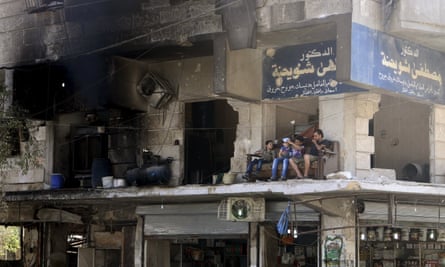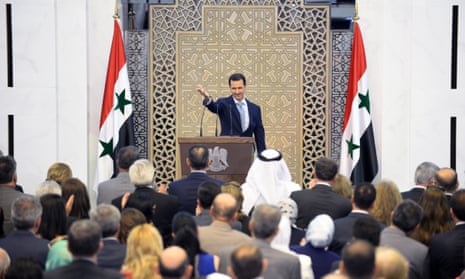The growing anarchy and stalemate in Syria has brought the country closer to de facto partition, as the overstretched and exhausted army of the president, Bashar al-Assad, retreats in the face of a war of attrition that has sapped its manpower.
The regime’s military has sought to retain a footprint in far-flung areas of the country, from Deir Ezzor in Syria’s eastern desert to Aleppo in the north and Deraa in the south, attempting to consolidate its hold over state institutions and protect its officer corps by retreating in the face of overwhelming offensives and subjecting lost territory to relentless and indiscriminate aerial campaigns.
But, facing a manpower shortage as tens of thousands of young men desert, the military has had to rely largely on local militias as enforcers for the regime. It is ceding territory to rebel fighters and the terror group Islamic State in favour of regrouping in its strongholds to the west, slowly paving the way for partition.
The assertive Islamism of some of the most powerful rebel groups has ensured that a military solution to the four-year conflict – which has claimed nearly a quarter of a million lives – is all but impossible in an increasingly fractious and complex battlefield.
In an unusually frank assessment in late July, Assad effectively ceded control of large tracts of the country by admitting that regime troops were overstretched and could not be present in all areas of Syria. Nevertheless, he pledged to continue waging the war.
“When we want to concentrate our forces in an important area … this sometimes comes at a cost to another area which is weakened, and at times we have to abandon those areas in order to move forces to the area we want to hold,” Assad said in a televised address. He also admitted that the Syrian army is facing a manpower shortage.
It is a wildly complicated battlefield, where clear frontlines remain largely elusive more than four years into the rebellion. Rebel advances belie the nuances of a brutal war where the government remains in control of major population centres and has preserved the institutions of state and its officer corps.

Though it has lost substantial territory recently, including almost all of the province of Idlib in the north and the historic city of Palmyra, the regime has held on to strategic military bases including the airport in Deir Ezzor, the T4 base in eastern Homs and the Tha’ala base in the south, near Deraa.
“There was a practical calculation in Palmyra,” said Kheder Khaddour, a Syrian expert with the Carnegie Middle East Center who has studied state institutions and their activities during the war. “There was no real confrontation with Daesh [Isis], and they preferred to withdraw in the face of a powerful offensive as they don’t want to lose army officers.”
Withdrawals likely preserved the lives of hundreds of officers, allowing them to regroup closer to the regime’s western heartland, where it controls major population centres like Hama, Homs, Damascus and Latakia.
In Aleppo, the rebels and their backers fear the total collapse of services in the city and worry about governing the millions of civilians still living in the government-held areas under what is likely to be a vengeful and brutal aerial campaign. In Deraa, their offensive is complicated by the need to decide on the future place of the Druze community in Suweida in southern Syria, who fear the ascent of jihadi groups like the al-Nusra Front – who see them as heretics – a concern shared by other minorities.

In areas where Assad’s troops have fled, the regime launched relentless barrel bombing campaigns aimed at making life unbearable for civilians under rebel control and preventing the opposition from providing services that the state would normally offer, prompting civilians to flee to regime-held areas. The fractiousness of the opposition, which has struggled to manage its new territory, also hints at the challenges that lie ahead for the rebels.
“People are fleeing to the places where the bombing is originating,” said Khaddour. “It’s clearer for people because there is a state. The regime is a source of violence, but people go there to avoid the violence.” But the manpower shortage remains the Assad regime’s achilles heel – it could never really defeat the country’s demographics, maintaining Alawite rule over an overwhelmingly Sunni populace, and it has faced significant challenges mobilising foot soldiers to fight its war. The regime has tried to lure back deserters by issuing a general amnesty a day before Assad’s speech, lifting fines and punishments on those who fled military service.
“What you are seeing is a war of attrition with the regime in a downward spiral,” said Amr al-Azm, a former Syrian official who is now an activist with the opposition. “It’s not a case of if but when it’s going to lose Deraa and Aleppo.”
Last month, the Syrian Observatory for Human Rights, a monitoring group with wide contacts inside Syria, said that 70,000 individuals have avoided compulsory army service. The regime has sought to deploy thousands of local militiamen under the umbrella of what it calls the National Defence Forces, using them as shock troops directed by the army.
The institutionalisation of the militias has given the army some breathing space to continue to prosecute the battle, ceding much of its role to irregular forces.
“The regime took a big hit in the spring time with the loss of Idlib and Palmyra and Jisr al-Shughour and it looked to some that the regime’s wheels were falling off,” said Joshua Landis, a long-time Syria observer and director of the Center for Middle East Studies at the University of Oklahoma. “But in fact the regime has once again shown that it is capable of responding to these setbacks by changing its modus operandi.”
Landis said the growing power of the militias and the high number of draft dodgers was an indication of the weakness and exhaustion of the Syrian military, and particularly Assad’s Alawite base, after a four-year insurgency.
But he said the regime’s resilience in fighting for Aleppo and Deraa is likely because it feels its own legitimacy is under threat if it cedes most of Syria to the rebels. Such an event would spell a de facto partition of the country, an issue “so freighted with notions of surrender, great power conspiracy, Sykes-Picot 2”.

Its persistence in trying to hold those two cities comes despite urging by Iran that the regime focus on holding its core strongholds in the western part of the country.
The loss of Aleppo and Deraa would restrict the Syrian regime to a strip of territory in the west, stretching from Damascus through Homs, Hama and Latakia, and the Qalamoun mountain range straddling the Lebanese border that is defended by Hezbollah. Landis said many Syrians, and Alawites in particular, are privately acknowledging that partition is the likely outcome of the war, a notion fuelled by the decreasing likelihood of an outright military victory, the primacy of hardline conservative groups such as the al-Qaida affiliate al-Nusra Front and the salafist Ahrar al-Sham, and the failure of fractious rebel coalitions to govern liberated territories under persistent regime aerial campaigns.
In a recent interview, the al-Nusra Front’s leader said Alawites must abandon both the regime and their religion in order to coexist with other Syrians if the regime falls. Such statements mean that Assad preserves his constituency of middle and upper class Syrians and minorities, said Landis.
“It means he can continue to fight his war,” he said.

Comments (…)
Sign in or create your Guardian account to join the discussion